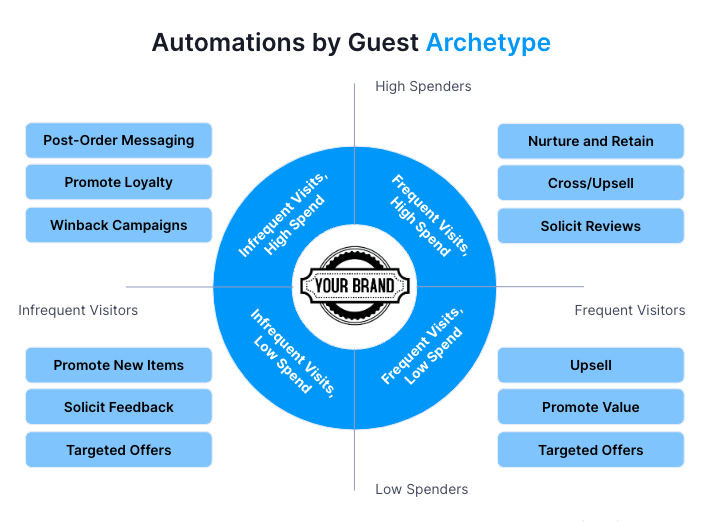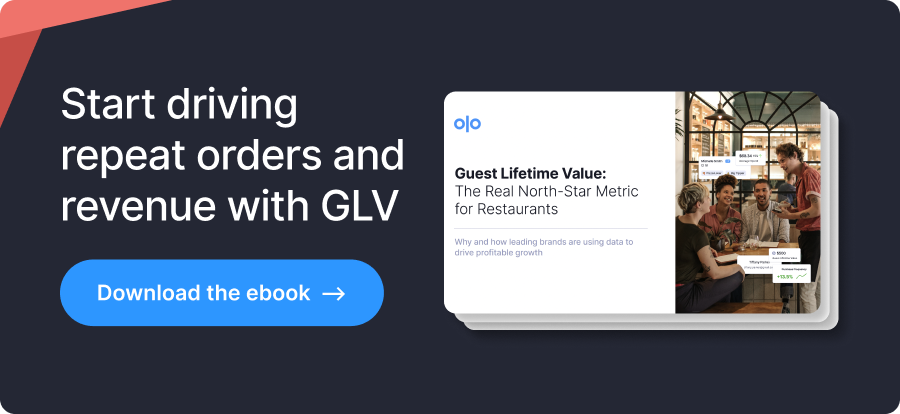
This article outlines:
Benefits of marketing automation for restaurants
Marketing automation stats restaurants should know
12 examples of restaurant marketing automations
Imagine having unlimited time and resources to develop marketing campaigns for every single restaurant guest based on their unique behavior. This is precisely what marketing automation unlocks—it turns one-to-one marketing from an aspiration to a reality.
Why is personalization so important? Because people want to feel seen. In a recent survey, restaurant guests said personalized recommendations (70%) and emails featuring their name (59%) made them feel known. When guests feel connected to your brand, they’re more likely to return and spend more.
It’s one of the reasons leading restaurants like Ted's Montana Grill and First Watch have largely moved away from batch-and-blast guest communications to hyper-targeted automations powered by data.
Here are a few ways restaurants can benefit from marketing automation.
Benefits of marketing automation for restaurants
- Scalably orchestrate multi-touchpoint guest journeys that drive order frequency, retention, and spend
- Maximize marketing ROI and deepen relationships with guests by reaching them at the right time, on their preferred marketing channel, with the right message
- Save time and manual work with a tool that offers a guided automation builder and a library of recommended automations—no IT support required
For further proof of its effectiveness, look at the following statistics.
Marketing automation stats restaurants should know
- $5.44 is the average return for every $1 spent on marketing automation
- Automated welcome emails from restaurants have an average open rate of 75%
- The average re-order rate from automated reminders for takeout is 15%
- First Watch email recipients spent $2.7M within 90 days of the brand launching a marketing automation
- Sonny’s BBQ saw a 50% increase in marketing subscribers and a 32% lift in engaged contacts with behavior-based automations
When done correctly, marketing automation can help you drive restaurant guests further down the funnel to habituation, all based on their unique interactions with your brand.
Questions to answer before launching marketing automations
It’s important to clearly define your objective and how you plan to influence guest behavior before launching a marketing automation. To achieve your desired outcome, you must reach a subset of guests at the ideal time on their preferred marketing channel—with impactful messaging.
Ask yourself the following questions to get the most bang for your buck.
Strategy
- What are the guest behaviors you are trying to encourage? (move guests from one to three visits, get off-premise-only guests to try dining in, etc.)
- When a guest takes a specific action, what would you like to happen?
- How are you measuring guest engagement and lifetime value?
Journey orchestration
- What data sources and events are you capturing in your CRM or guest data platform (GDP)?
- How would you ideally configure the guest journey in different scenarios?
Execution
- What content do you want to display to the guest?
- What channels will you be using to reach guests?
Once you have a game plan, you can develop targeted, timely automations to nudge each guest archetype toward your desired business outcomes. Keep scrolling for some restaurant-specific examples.
12 examples of restaurant marketing automations
A high-spending guest who orders three times a year shouldn’t receive the same marketing message as a low-spending but consistent regular. The same goes for meat lovers and vegetarians.
With your GDP, you can create complex guest segments—by purchase behavior, order frequency, dietary preferences, preferred marketing channel, and more—and use marketing automation to influence their behavior.
Here are some examples of automations you can set up by guest archetype.

Infrequent visitors, high spend
- Post-order messaging: Nurture first-timers with a welcome series or a survey and send them an offer to encourage another order
- Promote loyalty: Send a post-order thank you message to deepen your connection with these guests and invite them to join your loyalty program
- Winback campaign: Improve order frequency by reminding these guests about their favorite menu items and consider enticing them with an LTO
Infrequent visitors, low spend
- Promote new items: Pique their interest by featuring new items related to their past purchases and providing an exclusive offer to try them
- Solicit feedback: Proactively send guests post-order, post-visit, or item-specific surveys to identify what is causing positive and negative experiences—and address any issues before they impact sales
- Targeted offers: Increase engagement and retention with a personalized birthday message and special redeemable treat
Frequent visitors, high spend
- Nurture and retain: Suggest related premium menu items or food pairings to these guests based on their order history to increase margins
- Cross-sell or upsell: Drive spend by highlighting your most popular and profitable takeout menu items to your off-premise regulars
- Solicit reviews: To boost retention, ask your VIPs to leave a review and reward their loyalty with early access to promotions and events
Frequent visitors, low spend
- Upsell: Showcase LTOs and food pairings that high-value guests often order
- Promote value: Highlight savings with bundled menu items to increase average check size
- Target offers: Slip a special dine-in-only promotion in their takeout bag to encourage on-premise orders
Now that you’ve got some inspiration for guest segments and automations, let’s get into the building blocks of marketing automation.
Steps for setting up a restaurant marketing automation
With a restaurant-specific marketing automation tool, you can get started in a few steps.
1. Set trigger: The action, behavior, or event that prompts the automation
- Examples: Order completed, party seated, guest birthday, etc.
2. Pre-entry filter: Additional conditions a guest must meet to be eligible for the automation
- Examples: Event, segment, attribute, etc.
3. Entry recurrence: Frequency in which guests enter the automation when meeting other criteria
- Examples: Every time, only the first time, once every X days
4. Add action: Final output of the automation received by the guest
How Olo can help
No matter how familiar you are with automations, Olo Engage can help you level up and scale your restaurant’s one-to-one marketing program. By leveraging Olo’s GDP and Marketing solutions, you can build automated guest journeys with behavior-based personalization and maximize campaign ROI.
“If you have insight into purchase behaviors, dietary restrictions, payments, and preferences all in one place, you can drive guest lifetime value,” said Ray Gallagher, VP & GM Engage. “When you serve guests the right information at the right time, you can influence their behavior—like increasing order frequency and check average—long-term.”
For more information about how marketing automation can save your restaurant time and drive revenue, request a demo of Olo Engage.

Photo by Ono Kosuki at Pexels

